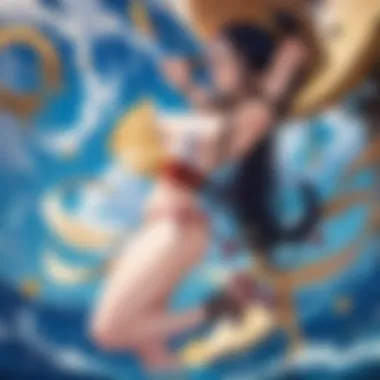In-Depth Analysis of One Piece Episodes and Themes


Intro
The journey through the vast world of One Piece is an odyssey of excitement and intricacy, captivating audiences for over two decades. With its rich tapestry of characters and intricate story arcs, the series has transformed from a simple pirate adventure into a profound exploration of dreams, friendship, and resilience. This article serves as a comprehensive guide, dissecting the episodes of One Piece in a way that not only honors the legacy of Eiichiro Oda's creation but also provides keen insights into the elements that have captured the hearts of fans worldwide.
From the early adventures in East Blue to the confrontations in the New World, each episode builds upon significant themes threaded throughout the series: loyalty, ambition, and the enduring quest for freedom. Understanding these episodes is critical in appreciating how they intertwine to form such a rich narrative.
What follows is an in-depth look at the episodes, character development, and underlying themes, crafted for those who truly wish to dive beneath the surface of One Piece. Let’s begin this grand exploration.
Episode Reviews
Summary of the episode
One Piece episodes are organized into arcs that often encapsulate specific narratives or adventures. Each episode typically begins with a brief recap of critical events leading up to it, setting the stage for the unfolding drama. For instance, the Enies Lobby Arc, where the Straw Hat Pirates confront the CP9 agents, encapsulates intense emotions and high-stakes action.
Analysis of key events
Take episode 809, “The World's Greatest Adventure,” for example. This episode is significant due to the revelations about the Revolutionary Army and their impact on the world dynamics. Key events like Luffy's interactions with Sabo deepen the storyline while revealing hidden motives affecting larger world affairs. The pacing maintains a sense of urgency, keeping viewers on the edge of their seats.
Discussion on character development
Characters within One Piece experience profound growth, often reflected through their relationships and challenges. In the Dressrosa Arc, for instance, we witness Zoro's unwavering loyalty towards Luffy, showcasing his commitment and the series' recurring theme of camaraderie. Such moments not only flesh out the character but also contribute to their overarching development.
Highlight memorable moments
Iconic scenes resonate with fans long after the credits roll. Consider the emotional resonance of Luffy declaring, “I don’t want to conquer anything. I just think the guy with the most freedom in this whole ocean is the King of the Pirates!” Such declarations encapsulate the core spirit of One Piece, infusing every episode with a sense of purpose and adventure.
Character Spotlights
Background information on the character
Characters like Nami, the clever navigator with a tumultuous backstory, exemplify the depth found within the One Piece world. Her journey from a thief trying to free her home to a valued crew member illustrates the complexity that lies beneath the surface.
Personality traits and unique quirks
What makes Nami memorable are her fierce independence and her wily nature when dealing with money. Her catchphrase when discussing bounties, “More treasure means more trouble,” taps into her knowledge of the pirate lifestyle, revealing her practicality.
Role in the storyline
Nami aids the crew not just by navigating but also by understanding the weather, which becomes pivotal in battles. Her talents often swing the tides in their favor and reinforce her indispensable role within the ensemble.
Fan theories and speculations
Fans frequently hypothesize about Nami’s origins and her past with Gol D. Roger’s crew. This leads to a wider discussion about the connections between characters and their legacies, fueling speculation on future plot threads.
Anime vs. Manga Comparison
Plot differences between the anime and manga
It's fascinating to note that the anime occasionally diverges from the manga. In certain fights, the manga might present dramatic moments with more straightforward choreography, while the anime amplifies scenes, providing additional context or extended sequences. This offers viewers a different lens through which to appreciate these confrontations.
Art and animation quality
The art style of the anime has evolved impressively, particularly in later episodes, where the quality of animation enhances the storytelling. Characters move with greater fluidity, and fight scenes showcase an engaging visual flair that captivates audiences.
Character portrayal
The portrayal of characters can subtly shift between the mediums. For example, Sanji's charm and flirtations are often played up in the anime, making him appear slightly more exaggerated than in the manga's pages.
Fan preferences and opinions
Fans are often divided between the two. Some appreciate the raw pacing of the manga, while others enjoy the soundtracks and voice acting of the anime. Discussions on forums like Reddit often highlight these differing opinions, showcasing preferences for the character development height in certain arcs.
Industry News and Updates
Announcements on upcoming releases
As One Piece continues to dominate discussions within the anime community, recent announcements have sent waves across various platforms. Updates about new seasons or films, such as the highly anticipated One Piece Film: Red, have fans abuzz with excitement.
Analysis of industry trends
Moreover, observing how One Piece remains relevant in the age of streaming services highlights the evolution of the anime industry. The show continues to adapt and thrive amidst changing viewer habits.
Insight into the production process
Gaining insight into the production choices made by the team reveals the labor of love that goes into each episode, from animation techniques to voice casting, ensuring that every frame serves the story well.
Top Lists
Ranking of favorite characters or episodes
Creating lists around favorites can be a light-hearted yet intense discussion point. Characters like Monkey D. Luffy and Roronoa Zoro often find themselves in the top echelon due to their unforgettable arcs and interactions.
Compilation of best fight scenes


Memorable battles, such as Luffy versus Crocodile, flow into animated countdowns that highlight the dynamic nature and stakes of confrontations.
Comparison of different genres within anime and manga
The comparisons between One Piece and other series often reveal its unique blend of humor, action, and adventure, making it a standout in the shonen genre.
Audience polls and feedback
Feedback from viewers fuels optimism for future arcs, with fan polls frequently contributing to discussions on which direction the series should take next.
Fan engagement demonstrates that the journey with One Piece is never-ending as viewers eagerly anticipate the next turn in this great tale.
Exploring these aspects will not only enhance understanding but also enrich the experience of watching One Piece. The layers are many, and the adventure unfolds in ways that both new and seasoned fans can appreciate.
Preamble to One Piece
One Piece stands out as a monumental work in the realm of anime and manga. Understanding its genesis and core narrative lays the groundwork for appreciating its vast storytelling. In the ever-evolving landscape of entertainment, One Piece offers more than just adventure; it serves as a rich tapestry of themes and character dynamics that resonate deeply with its audience.
Origin and Creation
Launched in 1997, One Piece was created by Eiichiro Oda, a visionary whose early inspirations came from classic adventures and pirate lore. The manga’s debut was a part of Shueisha's Weekly Shōnen Jump, and it quickly captured the attention of readers. Oda's unique style melded humor, action, and emotional depth, allowing the series to cross generational lines.
Fans appreciate that Oda hadn’t merely decided to ride the popular wave of pirate stories. He incorporated complex world-building that drew readers into the Grand Line, a sea filled with fantastical islands and remarkable characters. From the outset, Oda engaged with themes like friendship, ambition, and freedom, establishing a foundation that would influence not just the series itself but also the broader landscape of anime and manga.
Overview of the Plot
At its core, One Piece revolves around the dreams of a young boy named Monkey D. Luffy, who sets sail to become the Pirate King. His quest emphasizes the pursuit of freedom and self-discovery. The plot serves as a canvas for tales of camaraderie and rivalries among diverse characters, showcasing how their destinies intertwine.
Across numerous arcs, the narrative takes us through lush landscapes and intense battles, while still delving into substantial topics such as justice, morality, and sacrifice. Every episode and chapter builds on Luffy's journey, enriching the overarching storyline and presenting opportunities for character evolution.
"The journey of a thousand miles begins with one step."
This quote resonates strongly with the overarching narrative of One Piece, symbolizing both Luffy's aspirations and the commitment of every Straw Hat crew member.
What sets One Piece apart is not just the grand adventure but the depth of its character arcs. As we traverse the seas, we encounter a plethora of allies and adversaries that shape Luffy's growth. This intricate plotting draws readers and viewers into a whirlpool of emotional and thematic complexities that are rarely paralleled in the medium.
The significance of comprehending One Piece goes beyond mere entertainment; it paves the way for a deeper engagement with its multifaceted storytelling and the rich cultural motifs it explores.
The Significance of Episodes in Storytelling
In the realm of anime, the episodic structure serves not merely as a vessel for storytelling but as a powerful mechanism that drives character arcs and thematic expression. The episodes in One Piece encapsulate essential moments that form the backbone of its extensive narrative. Each episode, whether it's a thrilling battle or a brief moment of respite, plays a crucial role in weaving a rich tapestry of storylines, character growth, and emotional resonance. This examination extends beyond mere segmentation; it delves into how the layout and pacing of episodes enhance the overall experience.
Episodic Structure
The episodic structure of One Piece stands as a hallmark of its storytelling approach, offering an effective means of sustaining viewer engagement over the long haul. Unlike series that may rely heavily on a linear arc, One Piece employs a unique blend of episodic adventures interspersed with overarching themes and arcs. This strategy permits audiences to appreciate each installment's individuality while still grasping their part in the grand narrative. Not surprisingly, the varying lengths of arcs allow for flexibility in storytelling, letting the creators explore nuanced aspects of both the world and its inhabitants.
For instance, the East Blue Saga unfolds with a sequence of episodes introducing major characters one after another, each bringing their own unique motivations and backstories to the forefront. These initial episodes lay the groundwork for complex relationships and conflicts that resonate for decades.
Moreover, the structure allows audiences to consume the story at their own pace, permitting deeper emotional connections to develop in tandem with individual character journeys.
- Focused Themes: Each episode can spotlight specific themes, ranging from friendship to betrayal, without overwhelming viewers with too many concepts at once.
- Character Development: As viewers follow the adventures, they see characters evolve through their choices and interactions over time, leading to more authentic character realism.
This meticulous structuring ultimately serves to enhance audience anticipation and excitement, as fans often find themselves eager to see how the characters will tackle their next challenge in a seemingly limitless world.
Character Forewords
Character introductions in One Piece are not simply expositional; they are carefully crafted moments that set the tone for each character's arc. When a new crew member joins Luffy, say for example, the vibrant and boisterous Franky, the episode not only presents that character's backstory but also reveals what differentiates them from the rest of the ensemble.
Each introduction is marked by distinct storytelling techniques that emphasize the character's role, motivations, and quirks. For example:
- Dramatic Tension: The introduction of a character often involves elements of conflict or mystery, drawing viewers into the episode and making them invested in the outcome.
- Emotional Resonance: By the time a character like Nico Robin steps into the spotlight, the audience has witnessed her struggles and triumphs, leading to a richer understanding of her motivations.
Additionally, the beauty of these introductions lies in their ability to pivot the series towards new themes and challenges. They expand the lore around the world of One Piece, introducing new factions, ideologies, and even moral dilemmas that complicate the story and keep viewers on their toes.
As a result, character introductions have significant implications that extend beyond episode borders, influencing long-term narrative development and viewer investment in the character's journey. This intelligent layering of character arcs ensures that, no matter how many episodes someday comprise the series, audiences will remain engaged and eager for what unfolds next.
"The strength of One Piece lies in its ability to combine a multitude of episodic journeys, each contributing to the richness of an overarching narrative."
In summary, the significance of episodes in One Piece serves multiple facets of storytelling. They don't merely divide a long narrative; they form an intricate design that allows characters to thrive, themes to blossom, and viewers to find deeper meaning in the pursuit of a pirate's dream.
Key Episodes and Arcs
In the grand tapestry of One Piece, episodes and arcs are not just mere transitions from one adventure to another; rather, they form the bedrock of the narrative, giving depth to character development and enhancing thematic elements. These key episodes, stitched together throughout various arcs, significantly shape the overall persona of the Straw Hat Pirates while anchoring the viewers in a thriving world filled with excitement and emotion.
Each arc serves as a microcosm of the series' broader messages — friendship, ambition, and the eternal quest for freedom. Thus, the following sections analyze significant arcs which have not only been pivotal for character evolution but also resonated deeply with fans, cultivating an enduring legacy.
The East Blue Saga
The East Blue Saga lays the cornerstone for everything that follows – introducing fundamental characters and instilling the series' core themes. The saga begins with Luffy, a spirited boy with an unusual dream; becoming King of the Pirates. This segment introduces pivotal figures like Zoro and Nami. Each encounter teaches them lessons about camaraderie and sacrifice.
The simplicity of the East Blue's storyline should not mislead the viewer. Set against a backdrop of diverse islands and unique cultures, this saga offers insight into the hardships the characters face initially. Notably, Nami’s tale reflects on trust, loyalty, and betrayal. It is in this arc that we see Luffy’s unwavering nature shine, exemplifying the creed that fierce loyalty can forge enduring friendships.
The Alabasta Saga
The Alabasta Saga elevates the stakes dramatically, entwining personal agendas with larger societal conflicts. Encompassing grandiose narratives involving the rebellious kingdom of Alabasta, this arc introduces Crocodile, one of the Seven Warlords of the Sea. His quest for power provides a formidable opponent and pushes our heroes to their limits.
This saga dives deeper into the concept of duty versus individual desires. Vivi, the princess, is an embodiment of sacrifice, raising questions about one's responsibility towards the greater good. Her journey alongside the Straw Hats solidifies their bond as they fight for something bigger than themselves. As battles rage and friendships are solidified, viewers witness growth not just in Luffy but across the crew, highlighting an essential element of One Piece: unity in diversity.


The Dressrosa Arc
The Dressrosa Arc serves as a showcase of both character depth and intricate world-building. Here, Luffy confronts Donquixote Doflamingo, a manipulative adversary whose power impacts not just individuals but entire nations. The literary elements at play elevate this arc, with themes of deception, resilience, and redemption woven throughout.
The characters are fleshed out in ways that invite audience empathy; Tontatta and the Toy Soldier narratives offer poignant reflections on lost hopes and recovery. This arc is rich in emotional highs and lows, showing that the measures towards freedom often come with heavy sacrifices. The intricate connections between characters and their backstories enhance viewer engagement, ensuring that the audience feels profoundly invested in the outcomes.
"Every straw in the wind can determine the course of a pirate's journey, from storms to tropical paradises. It’s the trivial moments that lead to monumental changes."
In summary, these arcs together create a framework that is much bigger than the sum of its parts. The significance of these key episodes cannot be overstated; they are the very threads that contribute to the rich fabric of storytelling in One Piece.
Character Development Through Episodes
Character development is a cornerstone of storytelling, particularly in a sprawling narrative like One Piece. The episodes serve as the threads that weave the intricate tapestry of character arcs, allowing viewers to witness growth, transformation, and evolution over time. In One Piece, each episode intricately contributes to the development of both main and supporting characters, enriching the story with emotional depth and relatability. This aspect not only enhances the investment of the audience in the characters' journeys but also serves to convey deeper themes woven throughout the series.
Moreover, the dynamic nature of character relationships influences individual growth trajectories. Conflicts, friendships, and rivalries create an interplay that results in nuanced character development, showcasing how experiences shape personal destiny.
Luffy’s Growth
Monkey D. Luffy, the series' audacious protagonist, exemplifies remarkable growth throughout One Piece. From the outset, Luffy is characterized by his carefree spirit and unyielding determination, but this initial simplicity gives way to more profound layers as the episodes unfold.
Luffy’s evolution is punctuated by critical moments that test and ultimately solidify his resolve. For instance, his confrontations with formidable foes like Crocodile and Doflamingo reveal not just physical prowess, but also the strategic thinking that emerges in tandem with leadership. His commitment to his crew, the Straw Hat Pirates, illustrates an expanding emotional depth, as he learns the weight of responsibility that comes with pursuing one’s dreams.
These formative experiences cultivate his growth. Through pivotal episodes, Luffy's understanding of friendship, sacrifice, and the bonds that tie his crew together becomes apparent. The turning point against Admiral Akainu during the Marineford Arc is a prime example, revealing Luffy's emotional vulnerabilities but also underscoring his fierce loyalty and determination to protect his friends. This shift in character not only reflects the hard lessons learned but also sets a standard for his progression as a captain and a friend.
Development of Supporting Characters
Supporting characters in One Piece are anything but trivial; they are essential to the richness of the narrative and often reflect or contrast Luffy's growth. Take Roronoa Zoro, for example. Initially introduced as an antagonist, Zoro quickly becomes a loyal ally, but his journey also unfolds intricately over the episodes. Each arc provides insight into his past, motivations, and the code he lives by, emphasizing the themes of loyalty and ambition.
The development of characters like Nami, Sanji, and Usopp showcases their personal struggles and triumphs, often aligning with the overarching narrative of pursuing dreams. Nami’s journey from a thief to a formidable navigator, driven by her desire to map the world, is particularly telling. The more we see her cope with past traumas and confront her fears, the deeper the audience's appreciation grows for her resilient spirit.
In essence, supporting characters in One Piece are vital threads that not only drive the plot but also enhance Luffy's journey by fostering growth through collaboration and conflict. Each character's unique backstory and evolution serve to enrich viewers' understanding of the broader themes, which resonate deeply within the world created by Eiichiro Oda.
"Without character development, one piece of storytelling can often fall flat, yet through One Piece, we witness how deeply interconnected growth arcs can create a compelling narrative that keeps audiences mesmerized."
Characters like Franky and Brook introduce humor and depth, demonstrating how even the light-hearted elements speak to serious undertones, making the emotional weight of the series feel all the more authentic.
Thus, the exploration of character development in One Piece through its episodes not only deepens the emotional ties among the audience but also ensures that each character leaves a significant impact that resonates long after viewing.
Cultural Impact of One Piece
The cultural impact of One Piece cannot be overstated. This series has carved its niche in both Japanese and global media, becoming a significant driver of anime and manga culture. To understand its importance, one must look into several facets: the influence on storytelling in anime, its role in shaping fan communities, and the way it promotes cultural exchanges.
One Piece’s epic saga transcends merely being an anime; it has evolved into a phenomenon that springs emotion and connection amongst its viewers. The intricate plots and the depth of character relationships allow different generations to relate to its themes of adventure, friendship, and perseverance. The unique storytelling style has set a standard for anime, leading many creators to draw inspiration from it, ensuring that its mark on the industry will endure for years.
Global Reception
The reception of One Piece across the globe has been overwhelmingly positive, but it wasn't always smooth sailing. When it first aired, the series faced challenges in attracting audiences outside Japan due to cultural barriers and the sheer length of the show. However, with persistence and a growing international fan base, One Piece managed to rise to prominence.
- Sales Figures: According to various sources, including Wikipedia, it has sold over 100 million copies worldwide, solidifying its status as one of the best-selling manga series.
- Awards and Recognition: Numerous accolades highlight its contributions to storytelling and character development in anime, making it a staple in awards lists.
As new viewers continue to discover One Piece, the global reception transforms over time. Online platforms like Reddit and Facebook are bustling with discussions, theories, and fan edits that keep the series alive in discussions.
One Piece in Popular Culture
One Piece occupies a significant space not just in the anime landscape but also in broader pop culture. Its influence spills over into various aspects of entertainment and media. For instance:
- Merchandising: Action figures, cosplay outfits, and trading cards help fans connect to the series on a personal level.
- Collaborations: The series has seen various collaborations with entities like LEGO and video game franchises, often creating buzz and excitement around new releases.
- References in Other Media: Not only does it inspire other anime creators, but you can also find nods to One Piece in films, music, and literature.
"One Piece isn’t just a story, it’s the lifeblood of countless creators and fans who connect through these narratives, bridging gaps across cultures."
In summary, One Piece serves as a cultural touchstone, facilitating connections among its viewers while influencing the wider realms of entertainment and storytelling. Its story, characters, and themes resonate with audiences worldwide, proving that sometimes, tales of adventure on the high seas can lead to relationships that span oceans of culture.
Themes Explored in the Series
In One Piece, the themes are not just backdrops; they serve as the very marrow of the story. The exploration of these themes opens pathways to understand the characters and their motivations profoundly. This depth provides the audience with a connection that is not merely visual but emotional and intellectual. By weaving in these essential themes, the narrative becomes a tapestry highlighting the struggles and triumphs of its characters, making the series resonate with viewers on a personal level.
Friendship and Loyalty
The bonds of friendship and loyalty are the lifeline of One Piece. From the very start, we see Luffy rally a diverse array of characters who each have their own unique backgrounds and ambitions. What’s striking is how these relationships are not shallow; they are forged through trials and tribulations. When one of the Straw Hat crew faces a setback, the others jump in, showing that the strength of their friendship often surpasses individual weaknesses.
"When you have good friends, you can conquer the world." This saying embodies the essence of the series. In One Piece, friendship isn't just a theme; it's a profound realization that through mutual support and understanding, challenges can be faced head-on.
Consider the bond between Zoro and Luffy—Zoro pledges to follow Luffy not merely as a captain but as a friend worthy of respect. This dynamic encapsulates the loyalty that grows within the crew and highlights how such relationships are cultivated. The moments when one member saves another, or the times when they unite in battle against powerful foes, serve as testaments to the weight that friendship holds in their adventures.
Moreover, loyalty is taken to another level when looking at the villains' backgrounds. Often, their motivations stem from lost friendships or broken promises, showcasing that betrayal cuts deeply, leaving lasting scars. This creates a duality where the audience can empathize with even the antagonists, understanding that loyalty, when broken, unleashes a torrent of feelings that can lead to dire consequences.
Pursuit of Dreams
The pursuit of dreams is another critical theme woven throughout One Piece. Every character carries a dream that propels them forward, anchoring their ambitions and influencing their actions. Luffy's quest to become the Pirate King isn’t just a title; it symbolizes his desire for freedom and adventure. Each crew member shares their own dreams, whether it’s Nami's wish to map the entire world or Sanji's ambition to find All Blue, the legendary ocean.
This theme acts as a driving force that unites the crew despite their differences. The determination to achieve their dreams not only fuels their individual story arcs but also stirs the story forward, creating an undeniable synergy.
The sheer act of pursuing a dream, irrespective of the obstacles, sends a powerful message. It tells the viewers that dreams are achievable, even if the road is rough. These aspirations can be seen as a metaphor for life, highlighting that every twist and turn, every battle lost or won, leads one closer to their goals.
In many episodes, the characters make sacrifices for their dreams, showcasing the theme's seriousness. Their journeys highlight persistence, resilience, and the emotional toll dreams can take. The struggles are palpable, whether it’s coping with loss or the burden of expectations. Through this, viewers are encouraged to reflect upon their own ambitions and the paths they tread.


In essence, the themes of friendship and loyalty, alongside the pursuit of dreams, serve as both the emotional hooks and philosophical musings that underpin the entire series. They not only enrich character development but also cultivate profound connections with the audience, ensuring that One Piece isn’t just an anime, but a lived experience for many.
Critique and Analysis of Selected Episodes
Examining the episodes of One Piece offers a glimpse into the thought process behind storytelling in anime. Each episode serves as a piece of a grand puzzle, contributing to character arcs and driving the plot forward. Understanding the critique and analysis of these episodes deepens appreciation for the intricate layering present in the series. This section aims to uncover nuances that make certain episodes memorable, while also considering the strengths and weaknesses in the execution.
Narrative Techniques
In the realm of anime, narrative techniques play a crucial role. One Piece, for instance, often uses non-linear storytelling. This approach might present flashbacks that enrich the main plot, allowing viewers to connect the dots across different timelines. A prime example includes episode 500, where Luffy's backstory intertwines with the present.
- Foreshadowing: Episodes often hint at future events, leaving breadcrumbs that enthusiasts love to analyze. This device keeps the audience engaged, eager for resolutions in later arcs.
- Character Perspectives: Shifting the focus between different characters during episodes can provide varied insights and drive tension. Episode 800, for instance, cleverly juxtaposes the struggles of Luffy with those of his foes, creating a palpable sense of conflict.
- Pacing Techniques: The pacing in One Piece often oscillates between dramatic tension and comedic relief. This blend allows viewers to feel the gravity of serious moments while still enjoying light-hearted interactions typical of the crew.
Visual Storytelling
Visual storytelling in One Piece is not just about flashy animations or colorful characters. It employs imagery effectively to convey deeper emotional undercurrents without dialogue, which is a testament to the skill of the animators.
- Symbolic Imagery: Many episodes incorporate symbols that resonate with the overarching themes. For instance, the repeated imagery of the Straw Hat flag symbolizes freedom and adventure, essential values of the series.
- Character Design: The unique designs of each character reflect their personalities and backgrounds. For example, Nico Robin's dramatic attire and flowing movements evoke mystery, paralleling her role in the narrative.
- Background Art: Environments are often meticulously crafted to enhance the atmosphere. Take the Wano arc, where the lush landscapes serve as a backdrop to the intense struggles between good and evil.
"One Piece is more than just a tale of adventure; it is a masterclass in narrative and visual coherence that invites viewers into its rich world."
In summary, critique and analysis of selected episodes in One Piece reveals a layered storytelling approach. The series excels in employing narrative techniques and visual storytelling methods that captivate its audience. By embracing these elements, viewers can not only enjoy the series on a surface level but also engage with its deeper meanings and artistic merit. This adds significant value to One Piece, setting it apart from numerous other anime offerings.
Viewer Reception and Interpretation
The Viewer Reception and Interpretation section holds a crucial role in understanding the significance of One Piece episodes. Analyzing how the audience receives and interprets the narrative reveals much about the show's broader impact and relevance. The way fans interact with episodes enhances the dynamics between creators and viewers, serving as a two-way street of creativity and appreciation.
Audiences don't just passively consume content; they engage with it in ways that can lead to profound interpretations. This engagement often brings forth lively discussions, analysis, and community formation around specific episodes or themes. That helps the franchise to evolve while establishing its cultural footprint. More than just entertainment, episodes provoke thought, spark discussions, and inspire theories that go far beyond what is shown on screen.
Fan Theories
One Piece has given rise to a plethora of fan theories, some ludicrously wild while others hold a glimmer of truth beneath layers of speculation. The intricate world building, character development, and layered plotlines encourage fans to piece together clues, leading to a vibrant tapestry of interpretations. For instance, theories surrounding the character of Monkey D. Luffy and the true nature of One Piece itself have captivated audiences for years.
- Theories about the One Piece itself: Many speculate that the treasure isn’t merely material but a representation of friendship, dreams, and the freedom of the sea, encapsulating the very essence of the series.
- X Reader theories: These ideas revolve around hidden meanings behind actions and dialogues, suggesting deeper connections among characters that might not be overtly expressed.
These theories not only amplify viewer engagement but also foster valuable discussions. They enrich the ongoing discourse about what makes One Piece remarkable, encouraging even casual viewers to think critically about episodes they watch.
Impact on Online Communities
Online spaces dedicated to One Piece have thrived, particularly in platforms like Reddit and Facebook. These communities serve as forums for fans to share their thoughts, predictions, and analyses around various episodes. They further enhance viewership experience by cultivating a social aspect to fandom, bridging the gap between isolation and shared enthusiasm.
- Subreddits dedicated to episode discussions or fan art, for example, allow fans to showcase creativity while theorizing about upcoming events or character arcs.
- Facebook groups offer a more personal connection, where fans can share experiences or memorabilia, collectively celebrating their love for the series.
"The discourse found in these communities transforms One Piece episodes from mere entertainment into a catalyst for friendships and discussions among fans."
The flow of ideas and interpretations within these spaces solidifies One Piece not just as a series, but as a significant cultural phenomenon deserving of study and appreciation. Thus, the exploration of viewer reception and interpretation opens up new pathways to understanding the multi-faceted tapestry of this landmark series.
The Future of One Piece Episodes
The ongoing saga of One Piece continues to capture the imaginations of fans around the globe. As the episodes progress, viewers wonder about the trajectory that this storied anime and manga will take. Understanding the future of One Piece episodes not only enhances appreciation for the series but also incites curiosity about what lies ahead for the beloved Straw Hat crew. The evolution of storytelling in One Piece signifies its adaptability and resonance within the anime landscape. This segment addresses critical aspects of what fans can anticipate, including upcoming arcs and potential story directions, underlining their relevance and impact on the broader narrative.
Upcoming Arcs
One of the most thrilling aspects of One Piece is the promise of new arcs that continue to shape the world and its inhabitants. With each saga, Eiichiro Oda, the creator and storyteller, invites viewers deeper into a universe filled with rich lore and intricate character dynamics. Several upcoming arcs have been hinted at, generating excitement among fans.
- Wano Country Arc - Following the fierce battles and alliances forged in the preceding arcs, this arc is bound to delve into Samurai culture and advanced production of weapons, contributing significantly to the geopolitical dynamics at play.
- Elbaf - Known as the land of giants, Elbaf holds great potential for unveiling new aspects about the Straw Hats’ history and their connections to the larger world.
- Final Saga - Speculation abounds regarding when the Final Saga might commence, with theories suggesting it may feature massive showdowns that have been meticulously built up over the years.
The anticipation of new arcs not only keeps fans glued to their screens but also sparks discussions about lore, character connections, and overarching themes that may unfold.
Potential Story Directions
As the series progresses, one can only wonder how the trajectory of One Piece will unfold. Several potential story directions could significantly shape both character development and plot progression.
- Exploration of the Void Century - Unraveling the mysteries behind this lost era could raise the stakes significantly, likely introducing long-lost characters or uncovering ancient artifacts that affect the present.
- Shift in Power Dynamics - With the current power players in the One Piece universe, any shift in balance can lead to unexpected alliances or betrayals, altering relationships that had previously seemed steadfast.
- Luffy’s Destiny - As the series hints towards an ultimate goal for Luffy, potential revelations about his lineage and the legacy of the Pirate Kings can redefine his journey upon reaching One Piece.
In looking ahead to these pivotal shifts, fans are not just spectators but active participants in the unfolding drama of One Piece. Each episode remains an integral piece of a larger puzzle as Oda artfully threads connections between past and potential futures.
"The future is uncertain, but beyond every horizon lies adventure."
As One Piece sails forward, the anticipation of new adventures and revelations continues to excite its community, reinforcing its place in the culture of anime and manga.
Epilogue
The conclusion serves as a significant wrap-up to the elaborate journeys and adventures detailed throughout the article. It encapsulates the essence of the unfolding story arcs and character transformations within the One Piece universe. This section goes beyond merely summarizing; it invites readers to reflect on their own experiences with the series and the broader implications it carries in storytelling.
Reflections on the Journey
Diving deep into One Piece is akin to setting sail into uncharted waters. Each episode acts not just as a step forward in the narrative but as a mirror held to the viewer's journey. The characters, much like their audience, face trials and tribulations, evolving through encounters that teach resilience and camaraderie.
It's fascinating to reflect on how Luffy starts as a naive boy with a dream, and over countless episodes, he grows into a somewhat mature, albeit still carefree, captain.
In these reflections, we see how the series handles personal growth and transformation — not just for Luffy but also for the diverse cast that surrounds him. Each character, from Zoro to Nami, adds to the colorful tapestry, creating a shared experience for audiences worldwide. This evolution has sparked conversations near and far, resonating with those who may find themselves on a similar voyage of self-discovery.
Legacy of One Piece
The legacy of One Piece extends beyond mere entertainment; it has carved its niche into the fabric of anime and pop culture, influencing creators and fans alike. Its themes of friendship, dreams, and perseverance have provided fodder for discussion and interpretation across various platforms, notably among the online communities that thrive on sites like Reddit and Facebook.
The series has also maintained an enviable position in global discussions on storytelling. One evident impact is how it has set new standards for character depth and narrative complexity in long-running series. Viewers often remember the emotional weight of arcs like the Marineford War or the unraveling of the Fish-Man Island saga.
Moreover, One Piece has inspired countless works, leading emerging artists to adopt the visual style, character dynamics, and overarching themes found within its episodes. This shows how a singular piece of work can ripple through time and various artistic expressions.
"One Piece isn’t just a series. It’s a phenomenon that defines generations of viewers and creators."







